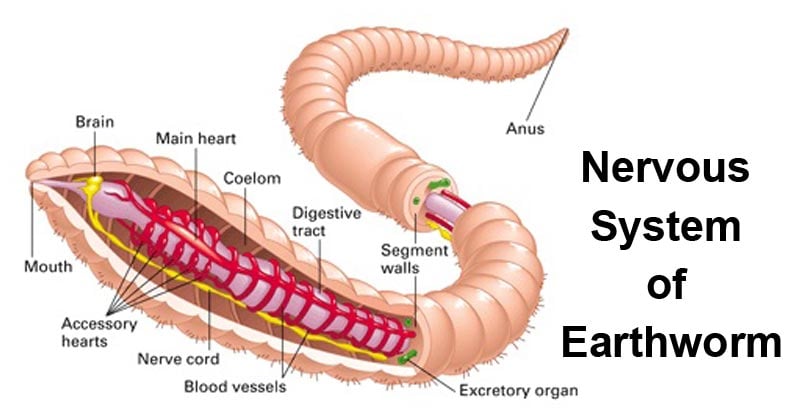- Well developed and concentrated nervous system.
- Consists of 3 parts: the central, peripheral, and sympathetic nervous system.

Figure: Nervous System of Earthworm. Image Source: Meridian Technical Charter High School.
1. Central nervous system
It comprises of the anterior nerve ring or brain ring and the posterior ventral nerve cord.
Nerve ring
- Comprises of cerebral ganglia or supra-pharyngeal ganglia, circumpharyngeal connectives, and subpharyngeal ganglia.
- A pair of closely united white, pear-shaped, cerebral, or supra- pharyngeal ganglia, forming the so-called brain.
- The brain lies dorsally in 3rd segment in the groove between the buccal cavity and pharynx.
- From the brain a pair of thick stout circum or peri-pharyngeal connectives arise, one on each side, embracing the pharynx and meeting ventrally in4th segment by a pair of fused sub-pharyngeal ganglia.
- In this way, a nerve collar is formed around the pharynx called a nerve ring or brain ring.
Ventral nerve cord
- Originates from the sub-pharyngeal ganglia and runs backward in the mid-ventral line to the posterior end of the body.
- It appears to be single but really is double and made of 2 longitudinal cords fused together in a transverse section.
- In each segment from 5th to the last, it presents a slight enlargement or a ganglion.
- Ganglia fused together as swellings representing the segmental ganglia.
- Histologically, the nerve cord consists of nerve fibers and nerve cells.
- Externally, nerve cords of Pheretima are solid an enclosed in a sheath called the perineurium.
- Perineurium consists of 3 layers- the outer peritoneum, middle thin layer of longitudinal muscle fibers, and inner thick fibrous layer of an epineurium.
- Both nerve cords are separated internally by a vertical epineurium.
- In the region of segmental ganglia,2 cores of nerve fibers are completely fused along the middle line.
- The ventrolateral region of the nerve cord contains bipolar and tripolar nerve cells all along the length.
- Nerve cells occur more in ganglia.
- Nerve cells and nerve fibers lie embedded in a mass of connective tissues, called neuroglia.
- Dorsally, 4 giant nerve fibers (1 median, 1 submedian, and 2 lateral) runs through the mass of connective tissues along the entire nerve cord.
- These nerve fibers surrounded by epineurium, all are tubular and filled with homogenous plasma-like matter which helps in their contraction.
- These fibers are responsible for the rapid conduction of impulses throughout the nerve cord.
- In the region of segmental ganglia, the partition between the 2 nerve cords are absent.
2. Peripheral nervous system
- From the brain 8 to 10 pairs of nerves arises which supply to the prostomium, buccal cavity, and pharynx.
- 2 pairs of nerves arise from the circumpharyngeal connectives supply 1st segment and buccal cavity.
- From the sub-pharyngeal ganglia, 3 pairs of the nerve arise supply to 2nd, 3rd, and 4th segments.
- Each segmental ganglion of the ventral nerve cord gives off 3 pairs of lateral nerves.
- One pair in front and 2 pairs behind the row of setae, they supply the various parts of the segment in which the ganglia are situated.
- Thus, the nerve originating from the central nervous system to supply the different parts of the body constitute the peripheral nervous system.
- Nerve are of mixed type, consists of both afferent or sensory fibers and efferent or motor fibers.
3. Sympathetic nervous system
- It consists of an extensive nerve plexus situated in the wall of the alimentary canal and some other internal organs.
- Such plexuses are connected with the per-pharyngeal connectives by fine nervules.
- They help in coordinating the functions of the related organs.
Working mechanism of the Nervous System
- All the activities of earthworm are under the control of the nervous system, though not necessarily of the brain.
- Like higher animals, they have both sensory and motor neurons.
- The nerves of the nerve cord have both sensory and motor fibers, i.e., mixed.
- Sensory fibers start from a sensory cell or receptor organs in the epidermis and terminate in the ventral nerve cord in fine branches.
- Near the branches in the cord, and forming a synapse with them, arise similar branches of motor fibers which run outward and terminate in muscles.
- Stimuli or sensory impulses are conducted from the receptor by sensory fibers to the ventral nerve cord, from where they are reflected motor impulses along efferent fibers to muscles which contract.
- The circuit of stimuli or impulses forms a simple reflex arc.
- The movement of circular and longitudinal muscles are co-ordinated, so the contraction of one bring about relaxation of the other.
- Giant fibers of the nerve cord conduct impulses more rapidly than other fibers resulting in sudden contraction of the whole body of earthworm when one point is strongly stimulated.
Video: Nervous System of Earthworm & its types By Studio Biology

References
- Kotpal RL. 2017. Modern Text Book of Zoology- Invertebrates. 11th Edition. Rastogi Publications.
- Jordan EL and Verma PS. 2018. Invertebrate Zoology. 14th Edition. S Chand Publishing.
